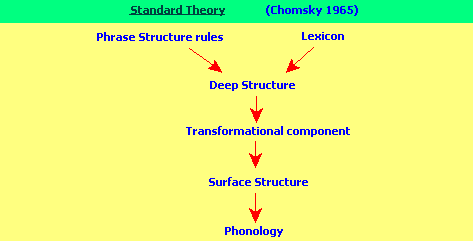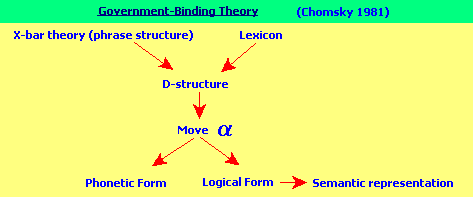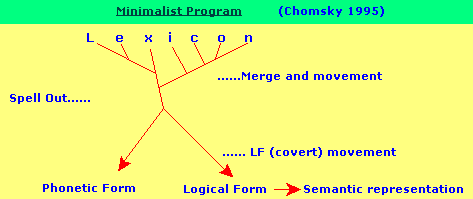page 3
http://threesology.org

Researchers as of 12/2/2019
| Pages in the Language Threes series | |||||
| 1 | 2 | 3 | 4 | A | B |
| C | D | E | F | G | H |
Three founding themes of generative grammar:
- Mentalism
- Combinatoriality
- Acquisition
Three major stages of Chomskyan syntactic theory:
- The Aspects theory.
- Principles and Parameters (or Government-Binding) Theory (Chomsky 1981).
- The Minimalist Program (Chomsky 1995).
Three major stages of Chomskyan syntactic theory- architecture of components:
 |
 |
 |
|
3 Noam Chomsky transformational grammar components:
3 to 1 ratio Noam Chomsky (1956) grammar hierarchy levels:
- 1 of 1. Type-0 grammars (unrestricted grammars) include all formal
grammars. They generate exactly all languages that can be recognized by a Turing
machine. The language that is recognized by a Turing machine is defined as all the
strings on which it halts. These languages are also known as the recursively enumerable
languages. Note that this is different from the recursive languages which can be
decided by an always halting Turing machine.
- 1 of 3. Type-1 grammars (context-sensitive grammars) generate the
context-sensitive languages. These grammars have rules of the form αAβ
-> αγβ with A a nonterminal and α, β and γ
strings of terminals and nonterminals. The strings α and β may be empty,
but γ must be non-empty. It can also include the rule S->ε. If
it does, then it must not have an S on the right side of any rule. These languages
are exactly all languages that can be recognized by a nondeterministic Turing machine
whose tape is bounded by a constant times the length of the input.
- 2 of 3. Type-2 grammars (context-free grammars) generate the
context-free languages. These are defined by rules of the form A ->
γ with A a nonterminal and γ a string of terminals and nonterminals.
These languages are exactly all languages that can be recognized by a nondeterministic
pushdown automaton. Context free languages are the theoretical basis for the syntax
of most programming languages.
- 3 of 3. Type-3 grammars (regular grammars) generate the regular languages. Such a grammar restricts its rules to a single nonterminal on the left-hand side and a right-hand side consisting of a single terminal, possibly followed by a single nonterminal. The rule S -> ε is also here allowed if S does not appear on the right side of any rule. These languages are exactly all languages that can be decided by a finite state automaton. Additionally, this family of formal languages can be obtained by regular expressions. Regular languages are used to define search patterns and the lexical structure of programming languages.
http://www.wikipedia.com/wiki/Chomsky+hierarchy
- 3 Esophagus parts: Pars Cervicalis~ Pars Thoracica~ Pars Abdominalis
- 3 single and 3 pairs of cartilage compose the frame (skeleton) of the larynx
- 3 basic parts to all languages: Subject~ Object~ Verb (not necessarily in this order)
- 3-model structure of all languages: Phonology~ Grammar~ Lexicon
- 3 parts to speech: Consonants~ Vowels~ Supra-segmentals
- 3 stress forms in language: Primary~ Secondary~ Weak
- 3 English Language divisions: Old~ Middle~ Modern
- 3 Archaic Chinese Language divisions: Early~ Middle~ Late
- 3 sentence Ending punctuation marks: Period~ Question Mark~ Exclamation Point
- 3 sentence Types: Simple~ Compound~ Complex
- 3 library researches: Author~ Title~ Subject
- 3-part mnemonic rule: I before E except after C
- 3 Noun/Pronoun types: Person~ Place~ Thing
- 3 Pronoun types: First person~ Second person~ Third person
- 3 Personal Pronoun Cases: Subjective~ Objective~ Possessive
- 3 Personal Pronoun Genders: Masculine~ Feminine~ Neuter
- 3 Verb Moods: Indicative~ Imperative~ Subjunctive
- 3 Verb Inflections: Tense~ Mood~ Number
- 3 Adjective comparison degrees: Positive~ Comparative~ Superlative
- 3 Affix subdivisions: Prefixes~ Infixes~ Suffixes
- 3 correct basic punctuation units: Phrase~ Independent Clause~ Dependent Clause
- 3 word variation categories: Antonyms~ Homonyms~ Synonyms
- 3 types of Verbals (special forms of a verb): Gerund~ Infinitive~ Participle
- 3 successive stages of writing development: Logography~ Syllabography~ Alphabetography
3 or more items of equal importance in a series is sometimes referred to as a Rule-of-thumb for using commas.
3 basic strategies underlying writing systems differ in the size of the speech unit denoted by one written sign:
- A single basic sound.
- A whole syllable
- A whole word
3 operations involved in the understanding of sentences according to models of normal sentence comprehension:
- You have to parse the sentence into grammatical components such as subject and object (syntax).
- You have to retrieve from your knowledge of language the specific meanings of the nouns and verbs (semantics).
- You have to map semantics onto syntax.
3 types of messages:
- Nominal
- Expressive (sometimes called emotional)
- Predicative (sometimes called Propositional)
3 subtle knowledge criteria that young children are said to have, according to experimental evidence:
- Syntactic structure (Grammatical arrangement of words in sentences.)
- Phonology (Organization of the sound system.)
- Semantics (The meaning of a word, phrase, sentence, or text.)
(These 3 are thought not to have been learned by Induction~ Imitation~ Instruction.)
3 great writing steps:
- Sumerian phonetization
- West Semitic syllabary
- Greek alphabet
3 writing systems on Rosetta Stone:
- Hieroglyphics
- Demotic Script
- Greek
3 Mayan Codexs:
- Dresden Codex
- Madrid Codex
- Paris Codex
3 languages being spoken in Africa thousands of years ago derived from the evidence in the names of plants in modern African languages:
- Ancestral Nilo-Saharan
- Ancestral Niger-Congo
- Ancestral Afroasiatic
Signing apes achieve vocabularies of three year olds. |
3 languages on Sumerian Cuneiform:
- Semitic Babylonian
- Indo-European Persian
- Elamite
The Rongo- Rongo language of the ancient Easter Island inhabitants (who are thought to have built the large stone figures), is said to be arranged in triads, according to the New Zealand Linguist Dr. Stephen Fisher. (The written language is said to have existed for about 3 generations from the 1780's to 1865 and been influenced by the Spaniards in 1770.) For those of you who need reminding, know that Spaniards are part of the 3rd-born Indo-European group of peoples who tend to use three-patterned ideas more-so than Asians or Africans (or Islanders) and whose influence on such, frequently contributes to those groups using three-patterned ideas where they did not do so before.
3 (talking) drills:
- Imitation
- Substitution
- Transformational (Guided repetition to instill a particular aspect of language in a learner)
3 types of syllable stress by Sebastian Shaumyan (1987):
- Strong/Dynamic
- Quantitative
- Tonal/Musical
Three modes of a vibration:
Longitudinal as straight-line or back and forth; Transverse or zigzag 90° to the first and Raleigh or Love waves 90° to the first two modes and which are circular or vortexian and manifest primarily as elliptical or apsidal in shape. None of these modes can exist independent of the other two.
"The human ear cannot detect the triple chord of any vibration, or sounding note, but every sound that is induced of any range, high or low, is governed by the same laws, as regards triple action of such, that govern every sympathetic flow in Nature. Were it not for these triple vibratory conditions, change of polarity could never be effected, and consequently there could be no rotation."
Let us ask a question: Is it possible to identify potential criminals by an examination of vocal utterances in infants and children? If it is indeed true that criminals tend to use a (diametrically opposed) form of dichotomization in developing their world view more so than non criminals (the criminal sees the world in black/white, right/wrong, good/evil, rich/poor, smart/dumb, us/them, etc.), will this cognitive "pattern" be exhibited more often and for a longer duration in babbling, word phrases, and activities such as when playing with toys, other children, and methodology of organization?
Three recognizable axes of cell movement and cell-cell communication are formed during one of the most crucial stages of embryonic development called gastrulation:
- anterior-posterior
- dorsal-ventral
- and left-right
Children learning natural languages need to master a symbol system with both a constituent and a combinatorial structure... There are three main schools of theorizing as to how this mastery is accomplished:
- The 'interactive', which locates language-learning within its context of use.
- The 'cognitive', which locates language-learning as part of symbolic development in general.
- The 'autonomous', which emphasizes the independence of the study of grammatical competence from both language use and general principles of cognitive development.
Three stage division for the acquisition of syntax:
(1.) Presyntactic-
Early presyntactic word-combinations are of three types:
- The combination of words that reflect grammatically relevant real-world relations.
- A word plus an intonationally integrated but meaningless extra syllable.
- Formulaic or rote-learned sequences.
It is not clear whether there is any continuity between the combinatorial structures of this stage and those of the next, syntactic, stage, which lasts from about two to five years of age.
(2.) Syntactic-
First-language learners make very few errors in constructing complex grammars - a
fact supporting the claim that there are innate constraints, whether specifically
linguistic or not, on a learner's 'hypothesis space'. Analysis of errors in learning
suggests that morphological learning may occur via a probabilistic mechanism, whereas
syntactic learning may be based on different, possibly innate, principles.
(3.) Postsyntactic-
The final postsyntactic stage represents the integration of the newly-emerged syntactic system with the real-world knowledge the child has accumulated.
Three types of early functions of language:
- Solicitation of action - Social interaction - Joint attention
- Expression of affect
- Participation in games.
Later developments, such as (a) threatening, (b) promising, and (c) deceiving, have not been systematically studied.
by Carolyn Johnson, Henry Davis, and Marlys Macken
http://www.massey.ac.nz/~alock/hbook/kidslang.htm
3 common vocal behaviors of infants: babbling, cooing, and clicking their tongue. (There is an adult used language in Africa that relies on clicking sound.)
3 common references to the world an infant enters into: (a world filled with- sights, sounds, and sensations... received by highly specialized receptors in a baby's ears, eyes, and skin.)
Three types of learners: Listeners, Lookers and Movers.
When left entirely to their own devices, over time children tend to settle into a preferred way of learning to the point of screening out less familiar types of information. When this occurs, by first grade:
- A Looker may have difficulty mastering phonics.
- A Listener may be unable to memorize math facts on flash cards.
- A Mover may be up and out of his seat during classroom instruction.
Extremes of learning style can result in learning disabilities. This eventual outcome can be prevented by gently encouraging children as early as possible to welcome all types of input from their environment. A first step to accomplishing this is by identifying a child's learning style as early as possible. Then a parent can gently nudge a child to try out activities in his or her less favored ways of learning.
3 suggestions for developing Listener skills through interactions with your child:
- Make story time a regular practice. Check out books from the library or pick up used ones at garage sales. Playfully ask your child to point to objects you names and to repeat words you say.
- Keep hats, badges, old jewelry and other dress-up accessories on hand to encourage role playing and conversation.
- When your preschooler accompanies you on an errand, allow him or her to explore, touch and taste the things you encounter en route. Then talk about these things together.
3 suggestions for developing Looker skills in your preschooler:
- Offer your child a collection of small objects (such as crayons, colored pencils, erasers of different shapes), and make a game of sorting them by color, shape, or size.
- Look through family photo albums together. Help your child identify family members.
- Lie down together outdoors and watch the clouds go by. Look for animal and flower shapes in the clouds.
3 suggestions for enhancing Mover skills:
- Take regular trips to a neighborhood playground. Allow your child plenty of time to swing, climb the jungle gym or just run free.
- Encourage him or her to help you garden. Be physically active together as you dig a hole, pull weeds, and water the plants.
- Make a game out of pantomiming everyday actions such as sweeping, shaving, or ironing as you sing the old favorite, "This is the way we sweep the floor," etc.
Don't buy more toys! Activities the two of you share will stimulate your child's development better than anything money can buy. No toy can listen, look, or move with your child as well as you can.
by Lauren Bradway, Ph.D. LB@helpingchildrengrow.net
There are three types of behavioral tests for infant hearing ability:
- Threshold testing measures the quietest tones or speech that a child is able to hear.
- Word Recognition testing measures the child's ability to understand speech at comfortable loudness levels.
- Middle Ear testing searches for the presence of fluid or other middle ear dysfunction.
The results are presented in a diagram called a tympanogram.
by Paula Rosenthal, J.D.
Founder and Editor of --- HearingExchange..com ---
Three outcomes possible when setting your goal for an argumentative paper:
- The ideal outcome is that you will change your reader's point of view from opposition to agreement with your own.
- You will be able to modify our reader's point of view to bring it closer to your own.
- You will not change your audience's mind at all.
Page 413
Three parts to an argument:
- Assertion
- Evidence
- Warrant
Example:
- Assertion: We can expect college tuition to increase.
- Evidence: The cost of living keeps going up.
- Warrant: Since colleges are subject to the same economic pressures as everyone else, tuition increases will be necessary to meet rising costs.
Using an implied (hidden/concealed/subtle) warrant, and a different order of presentation, the above argument might be written:
- Evidence: Because the cost of living keeps going up.
- Assertion: we can expect college tuition to increase as well.
Page 417, Prentice Hall, Handbook for writers, tenth edition, ISBN 0-13-695271-2 01, ©1988.
Page Created: Thursday, 13-November-2014... 5:42:19 AM
Maintenance of page update: Saturday, 13-Aug-2016... 02:34 AM
Former Update: Wednesday, 19-July-2017... 7:00 AM
Latest Update: Tuesday, 17th December, 2019... 2:18 PM
Herb O. Buckland
herbobuckland@hotmail.com